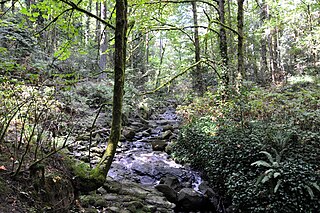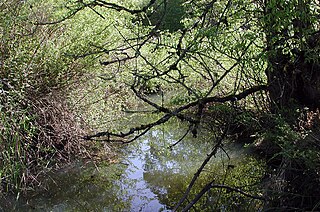Related Research Articles

The Homestead Acts were several laws in the United States by which an applicant could acquire ownership of government land or the public domain, typically called a homestead. In all, more than 160 million acres of public land, or nearly 10 percent of the total area of the United States, was given away free to 1.6 million homesteaders; most of the homesteads were west of the Mississippi River.

The Donation Land Claim Act of 1850, sometimes known as the Donation Land Act, was a statute enacted by the United States Congress in late 1850, intended to promote homestead settlements in the Oregon Territory. It followed the Distribution-Preemption Act 1841. The law, a forerunner of the later Homestead Act, brought thousands of settlers into the new territory, swelling their ranks along the Oregon Trail. 7,437 land patents were issued under the law, which expired in late 1855. The Donation Land Claim Act allowed white men or partial Native Americans who had arrived in Oregon before 1850 to work on a piece of land for four years and legally claim the land for themselves.

Forest Park is a public municipal park in the Tualatin Mountains west of downtown Portland, Oregon, United States. Stretching for more than 8 miles (13 km) on hillsides overlooking the Willamette River, it is one of the country's largest urban forest reserves. The park, a major component of a regional system of parks and trails, covers more than 5,100 acres (2,064 ha) of mostly second-growth forest with a few patches of old growth. About 70 miles (110 km) of recreational trails, including the Wildwood Trail segment of the city's 40-Mile Loop system, crisscross the park.
Brooklyn is a mostly residential neighborhood in southeast Portland, Oregon. It sits along the east side of the Willamette River in the vicinity of Reed College. Founded as a neighborhood in the late 1860s, the neighborhood today is a middle-class area comprising mainly single family homes, interspersed with remaining industrial sites along the river and a large railyard. This railyard was home to Southern Pacific 4449 as well as several other large antique steam and diesel-electric locomotives.

Leach Botanical Garden is a 16-acre (6.5 ha) botanical garden located in outer southeast Portland, Oregon, near S.E. 122nd Avenue and Foster Road. It was acquired by the Portland Parks Bureau in 1972.

East Portland was a city in the U.S. state of Oregon that was consolidated into Portland in 1891. In modern usage, the term generally refers to the portion of present-day Portland that lies east of 82nd Avenue, most of which the City of Portland annexed in the 1980s and 1990s.

Francis William Pettygrove was a pioneer and one of the founders of the cities of Portland, Oregon, and Port Townsend, Washington. Born in Maine, he re-located to the Oregon Country in 1843 to establish a store in Oregon City. Later that year he paid $50 for half of a land claim on which he and Asa Lovejoy laid out a town named Portland after the port city in Pettygrove's home state. Lovejoy preferred Boston, but Pettygrove won a coin toss giving him the right to choose the name.

Tryon Creek is a 4.85-mile (7.81 km) tributary of the Willamette River in the U.S. state of Oregon. Part of the drainage basin of the Columbia River, its watershed covers about 6.5 square miles (16.8 km2) in Multnomah and Clackamas counties. The stream flows southeast from the Tualatin Mountains through the Multnomah Village neighborhood of Portland and the Tryon Creek State Natural Area to the Willamette in the city of Lake Oswego. Parks and open spaces cover about 21 percent of the watershed, while single-family homes dominate most of the remainder. The largest of the parks is the state natural area, which straddles the border between the two cities and counties.

The Tryon Creek State Natural Area is a state park located primarily in Portland, in the U.S. state of Oregon. It is the only Oregon state park within a major metropolitan area. The 645-acre (261 ha) park lies between Boones Ferry Road and Terwilliger Boulevard in southwest Portland in Multnomah County and northern Lake Oswego in Clackamas County and is bisected from north to south by Tryon Creek. To the north, the park abuts the Lewis & Clark Law School campus.

Fanno Creek is a 15-mile (24 km) tributary of the Tualatin River in the U.S. state of Oregon. Part of the drainage basin of the Columbia River, its watershed covers about 32 square miles (83 km2) in Multnomah, Washington, and Clackamas counties, including about 7 square miles (18 km2) within the Portland city limits.

Balch Creek is a 3.5-mile (5.6 km) tributary of the Willamette River in the U.S. state of Oregon. Beginning at the crest of the Tualatin Mountains, the creek flows generally east down a canyon along Northwest Cornell Road in unincorporated Multnomah County and through the Macleay Park section of Forest Park, a large municipal park in Portland. At the lower end of the park, the stream enters a pipe and remains underground until reaching the river. Danford Balch, after whom the creek is named, settled a land claim along the creek in the mid-19th century. After murdering his son-in-law, he became the first person legally hanged in Oregon.

Rood Bridge Park is a municipal park in southeast Hillsboro, Oregon, United States. Opened in 1999, the park encompasses 60 acres (24 ha) on the north bank of the Tualatin River at its confluence with Rock Creek. Rood Bridge is near Hillsboro High School and sits across the river from Meriwether National Golf Course. The park is the city's largest, and contains tennis courts, a meeting facility, trails, a canoe launch, and a rhododendron garden among other features.

Socrates Hotchkiss Tryon Sr. was a pioneer physician in what became the U.S. state of Oregon. A native of Vermont, he later lived in Iowa and California before moving to the Oregon Territory where he settled the land that now comprises part of the Tryon Creek State Natural Area in Portland and Lake Oswego. He was also a member of the 1846 Iowa Constitutional Convention.
John Sellwood was a pioneer Episcopal minister who settled in the U.S. state of Oregon on a 321-acre (130 ha) donation land claim on the east bank of the Willamette River upstream from Portland.

Irving Park is a city park of about 16 acres (6.5 ha) in northeast Portland, in the U.S. state of Oregon. Located at Northeast 7th Avenue and Fremont Street in the Irvington neighborhood, the park is on land that was originally owned by William Irving, for whom the neighborhood was named. The Irvington Racetrack once occupied part of the land.

The John and Sarah Sheffield House, also known as Paradise Springs Farm, in southeast Portland in the U.S. state of Oregon, is a two-story dwelling listed on the National Register of Historic Places. Built in 1866 as a farm house, it was added to the register in 1991. It is one of the oldest remaining homes in its neighborhood.

James Terwilliger was an Oregon pioneer and one of the first residents of Portland, Oregon. He is the namesake of Portland's Terwilliger Boulevard and Terwilliger School.
Danford Balch was a mid-19th-century settler in what later became the Willamette Heights neighborhood of Portland in the U.S. state of Oregon. He was born on November 29, 1811, in Colrain, Massachusetts, but spent his early years in Onondaga County, New York. In 1850, Balch moved west to Portland, and settled on a donation land claim of about 346 acres (140 ha) with his wife, Mary Jane, and nine children. A commemorative stone at Northwest 30th Avenue and Upshur Street marks the spot of the Balch homesite. A family named Stump, with whom the Balches quarreled, settled a nearby claim.

Lewis Southworth, also identified as Louis Southworth (1830–1917), was an American pioneer in Oregon who settled a donation land claim in 1880 near Waldport in the U.S. state of Oregon. Southworth was born into slavery and brought to the Oregon Territory by his enslaver, from whom he bought his freedom with cash, earned chiefly from his expertise with the fiddle or violin. Southworth lived or worked near Monroe, Jacksonville, and Buena Vista before settling along a small tributary of the Alsea River, where he farmed and engaged in other enterprises and civic undertakings. After his first wife died in 1901, Southworth bought a house in Corvallis, where he lived for the rest of his life and married his second wife.

Letitia Carson was an Oregon pioneer and one of the first African Americans to be listed as living in Oregon according to the U.S. Federal Census. In fact, she was the only black woman to successfully make a land claim in Oregon under the Homestead Act of 1862. She was the inspiration for Jane Kirkpatrick's 2014 novel A Light In The Wilderness.
References
- 1 2 3 4 5 "Elizabeth Caruthers Park". City of Portland. 2015. Retrieved March 5, 2015.
- 1 2 3 Burnham, Howard J. (December 1952). "The Annual Society Address: For the Land's Sake!". Oregon Historical Quarterly. Oregon Historical Society. 53 (4): 223–234. JSTOR 20612081.
- ↑ Lansing, Jewel (2005). Portland: People, Politics, and Power, 1851–2001. Corvallis: Oregon State University Press. p. 75. ISBN 0-87071-118-0.
- 1 2 3 Short, Casey (1983). Water: Portland's Precious Heritage. City of Portland. pp. 2–3.